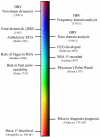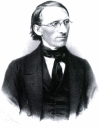Heart rate variability - a historical perspective
- PMID: 22144961
- PMCID: PMC3225923
- DOI: 10.3389/fphys.2011.00086
Heart rate variability - a historical perspective
Abstract
Heart rate variability (HRV), the beat-to-beat variation in either heart rate or the duration of the R-R interval - the heart period, has become a popular clinical and investigational tool. The temporal fluctuations in heart rate exhibit a marked synchrony with respiration (increasing during inspiration and decreasing during expiration - the so called respiratory sinus arrhythmia, RSA) and are widely believed to reflect changes in cardiac autonomic regulation. Although the exact contributions of the parasympathetic and the sympathetic divisions of the autonomic nervous system to this variability are controversial and remain the subject of active investigation and debate, a number of time and frequency domain techniques have been developed to provide insight into cardiac autonomic regulation in both health and disease. It is the purpose of this essay to provide an historical overview of the evolution in the concept of HRV. Briefly, pulse rate was first measured by ancient Greek physicians and scientists. However, it was not until the invention of the "Physician's Pulse Watch" (a watch with a second hand that could be stopped) in 1707 that changes in pulse rate could be accurately assessed. The Rev. Stephen Hales (1733) was the first to note that pulse varied with respiration and in 1847 Carl Ludwig was the first to record RSA. With the measurement of the ECG (1895) and advent of digital signal processing techniques in the 1960s, investigation of HRV and its relationship to health and disease has exploded. This essay will conclude with a brief description of time domain, frequency domain, and non-linear dynamic analysis techniques (and their limitations) that are commonly used to measure HRV.
Keywords: autonomic nervous system; frequency domain; heart rate variability; respiratory sinus arrhythmia; time domain.
Figures







Similar articles
-
[Heart rate variability. Applications in psychiatry].Encephale. 2009 Oct;35(5):423-8. doi: 10.1016/j.encep.2008.06.016. Epub 2008 Dec 18. Encephale. 2009. PMID: 19853714 Review. French.
-
Geometry of the Poincaré plot can segregate the two arms of autonomic nervous system - A hypothesis.Med Hypotheses. 2020 May;138:109574. doi: 10.1016/j.mehy.2020.109574. Epub 2020 Jan 20. Med Hypotheses. 2020. PMID: 32014816
-
Respiratory sinus arrhythmia during anaesthesia: assessment of respiration related beat-to-beat heart rate variability analysis methods.Int J Clin Monit Comput. 1997 Nov;14(4):241-9. doi: 10.1007/BF03356569. Int J Clin Monit Comput. 1997. PMID: 9451574
-
Heart rate variability: technique and investigational applications in cardiovascular medicine.Mayo Clin Proc. 1995 Oct;70(10):955-64. doi: 10.4065/70.10.955. Mayo Clin Proc. 1995. PMID: 7564548
-
[Heart rate variability].Nihon Rinsho. 1992 Apr;50(4):717-22. Nihon Rinsho. 1992. PMID: 1619751 Review. Japanese.
Cited by
-
Feasibility of Early Assessment for Psychological Distress: HRV-Based Evaluation Using IR-UWB Radar.Sensors (Basel). 2024 Sep 25;24(19):6210. doi: 10.3390/s24196210. Sensors (Basel). 2024. PMID: 39409250 Free PMC article.
-
How to Use Heart Rate Variability: Quantification of Vagal Activity in Toddlers and Adults in Long-Term ECG.Sensors (Basel). 2020 Oct 21;20(20):5959. doi: 10.3390/s20205959. Sensors (Basel). 2020. PMID: 33096844 Free PMC article.
-
Propofol suppresses the His-ventricular conduction in paediatric patients.J Clin Pharm Ther. 2021 Apr;46(2):433-439. doi: 10.1111/jcpt.13302. Epub 2020 Oct 24. J Clin Pharm Ther. 2021. PMID: 33098128 Free PMC article.
-
Peri-Ictal Autonomic Control of Cardiac Function and Seizure-Induced Death.Front Neurosci. 2022 Jan 21;15:795145. doi: 10.3389/fnins.2021.795145. eCollection 2021. Front Neurosci. 2022. PMID: 35126041 Free PMC article.
-
Use of behavioural and physiological responses for scoring sound sensitivity in dogs.PLoS One. 2018 Aug 1;13(8):e0200618. doi: 10.1371/journal.pone.0200618. eCollection 2018. PLoS One. 2018. PMID: 30067767 Free PMC article.
References
-
- Adamopoulos S., Ponikowski P., Cerquetani E., Piepoli M., Rosano G., Sleight P., Coats A. J. (1995). Circadian pattern of heart rate variability in chronic heart failure patients. Effects of physical training. Eur. Heart J. 16, 1308–1310 - PubMed
-
- Angelone A., Coulter N. A. (1964). Respiratory sinus arrhythmia: a frequency dependent phenomenon. J. Appl. Physiol. 19, 479–482 - PubMed
-
- Anrep G. V., Pascua W., Rossler R. (1936a). Respiratory variations in the heart rate I. The reflex mechanism of respiratory arrhythmia. Proc. R. Soc. Lond. B Biol. Sci. 119, 191–21710.1098/rspb.1936.0005 - DOI
-
- Anrep G. V., Pascua W., Rossler R. (1936b). Respiratory variations in the heart rate II. The central mechanism of respiratory arrhythmia and the inter-relationship between central and reflex mechanisms. Proc. R. Soc. Lond. B Biol. Sci. 119, 218–23010.1098/rspb.1936.0005 - DOI
LinkOut - more resources
Full Text Sources
Other Literature Sources
Medical

